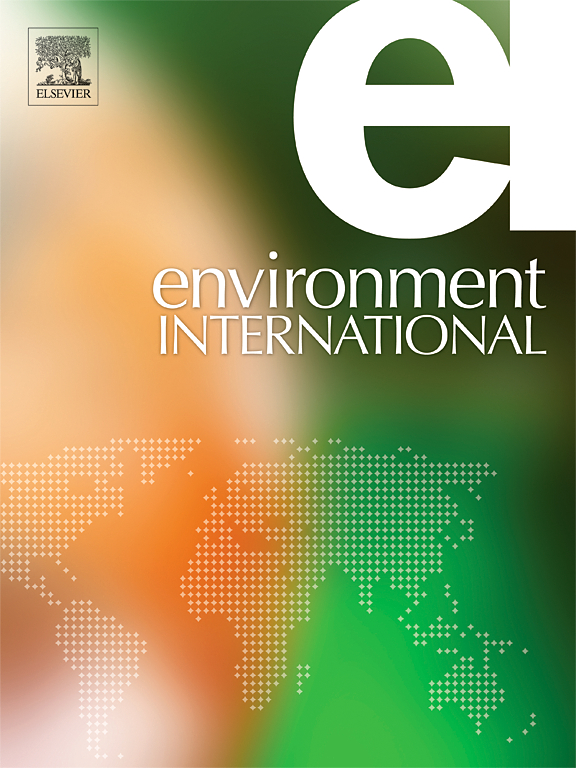雨水滞留盆地沉积物中的轮胎路面磨损颗粒、微塑料和金属:共现和生态风险评估
IF 10.3
1区 环境科学与生态学
Q1 ENVIRONMENTAL SCIENCES
引用次数: 0
摘要
由于工业活动和道路交通等人为来源,轮胎道路磨损颗粒(TRWP)和微塑料(MP)越来越多地存在于环境中。它们在城市沉积物中的负荷很高,更具体地说,在雨水管理基础设施(如滞留盆地)中负荷很高。在法国一个大都市取样了11个不同土地利用(工业、城市、农业和异质)的截流盆地,以研究土地利用如何影响这些盆地中TRWP、MP和金属的存在。结果表明,所有样品中TRWP浓度均高于MP,其中工业地区最高达20,191 mg。Kg−1和3266 mg。公斤−1,分别。城市相关金属(Cd、Cu、Pb、Zn)与TRWP、MP呈显著正相关。利用富集系数和污染负荷指数对流域的污染程度进行分类,表明所有流域都受到污染。对于相关的风险,计算了三种污染物的风险商。利用文献中可用的效应数据,对本研究中专门开发的TRWP提出了一个预测的沉积物无效应浓度(pnec沉淀物),设置为1,000 mg·kg−1。本文对两种方法(聚合风险指数和风险评分)进行了测试,以考虑MP在风险评估中的复杂性。两种方法显示出不同的结果,突出了在风险评估中考虑MP特征的重要性。本文章由计算机程序翻译,如有差异,请以英文原文为准。


Tire road wear particles, microplastics and metals in sediment of stormwater detention basins: co-occurrence and ecological risk assessment
Tire road wear particles (TRWP) and microplastics (MP) are increasingly present in the environment due to anthropogenic sources like industrial activities and road traffic. Their load is high in urban sediments and more specifically in stormwater management infrastructure such as detention basins. Eleven detention basins featured by contrasting land uses (industrial, urban, agricultural, and heterogeneous) were sampled in a French metropolitan city to examine how land use influences the presence of TRWP, MP, and metals in these basins. Results show that the concentration of TRWP is higher than MP in all samples, with the highest levels in industrial areas reaching 20,191 mg.kg−1 and 3,266 mg.kg−1, respectively. A positive and significant correlation is observed between urban related metals (Cd, Cu, Pb, Zn), TRWP and MP. The enrichment factor and pollution load index are used to classify the contamination of the basins and showed that all the basins are contaminated. Concerning the risk associated, a risk quotient is calculated for the three pollutants. A predicted non-effect concentration for sediments (PNECsediment) is proposed for TRWP specifically developed in this study using available effect data from the literature, which is set at 1,000 mg·kg−1. Two methods (polymeric risk index, risk score) are tested to consider the complexity of MP in the risk assessment, they are discussed in this study. The two methods show different results, highlighting the importance of considering the characteristics of MP in risk assessment.
求助全文
通过发布文献求助,成功后即可免费获取论文全文。
去求助
来源期刊

Environment International
环境科学-环境科学
CiteScore
21.90
自引率
3.40%
发文量
734
审稿时长
2.8 months
期刊介绍:
Environmental Health publishes manuscripts focusing on critical aspects of environmental and occupational medicine, including studies in toxicology and epidemiology, to illuminate the human health implications of exposure to environmental hazards. The journal adopts an open-access model and practices open peer review.
It caters to scientists and practitioners across all environmental science domains, directly or indirectly impacting human health and well-being. With a commitment to enhancing the prevention of environmentally-related health risks, Environmental Health serves as a public health journal for the community and scientists engaged in matters of public health significance concerning the environment.
 求助内容:
求助内容: 应助结果提醒方式:
应助结果提醒方式:


